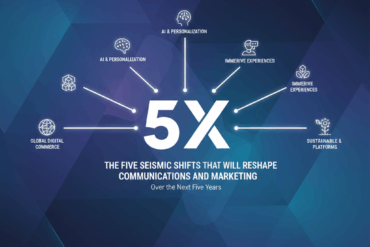Sourced from The Drum
Kicking off our Creative Technology for Drummies guide, our glossary helps navigate the tools, trends and terminology shaping the future of creativity.
From smart templates to scene detection, AI assistants to virtual production sets, creative tech is rewriting the rules of how brands make and scale ideas. But with new terms landing faster than you can say ‘generative fill,’ it’s easy to lose track of what’s worth your time (and what’s just buzz).
As marketing budgets tighten and expectations climb, creative teams are being asked to do more: more assets, more formats, more personalization – all while keeping it on brand and on budget. That’s where creative technology steps in.
Whether you’re experimenting with automation or re-platforming your entire production pipeline, this guide breaks down the tools, trends and terminology shaping the next wave of creative work.
10 creative tech terms you actually need to know
If your inbox is a blur of demos, decks and ‘new creative platforms,’ you’re probably not alone. Creative technology is booming, but in a world of hype, which terms should marketers actually know? Here are 10 essential concepts powering the next wave of brand storytelling, reshaping how ideas are made, scaled and personalized.
1. Generative AI
Why it matters: The engine behind text-to-image tools, creative assistants and AI-powered ad scripts. From concepting to content creation, it’s the biggest creative shift since the MacBook Pro.
2. Creative automation
Why it matters: Think hundreds of assets in every shape, size and language – all generated from one master visual. It’s what makes personalization profitable (and your design team less burnt out).
3. Prompt engineering
Why it matters: If generative AI is the paintbrush, prompts are the artist’s hand. Knowing how to write prompts that yield brand-right, on-brief output is quickly becoming a must-have skill.
4. Virtual production
Why it matters: Film anything, anywhere – no plane ticket required. Used in everything from Marvel to Ikea, it merges real actors with digital backdrops via LED walls and game engines.
5. Volumetric video
Why it matters: This is what makes holograms happen. Volumetric video captures motion in 3D, unlocking immersive brand experiences, digital twins and next-gen retail try-ons.
6. Modular content systems
Why it matters: Say goodbye to one-size-fits-all creative. Modular systems let you mix, match and adapt content across regions, platforms, and formats – without breaking your brand.
7. Scene detection
Why it matters: AI that scans videos to automatically cut, crop or tag content for reuse. A huge time-saver for brands producing at scale or remixing existing footage for new channels.
8. Dynamic creative optimization (DCO)
Why it matters: Real-time ad personalization, powered by data. Whether it’s weather-based offers or location-triggered messaging, DCO delivers bespoke creative at media speed.
9. Interactive storytelling
Why it matters: Ads aren’t just for watching – they’re for playing. Whether it’s a swipe-to-choose adventure or tap-to-style video, interactive formats give users skin in the game.
10. Style transfer
Why it matters: Want to apply your brand’s signature look to any visual? Style transfer uses AI to copy aesthetics across assets, turning moodboards into mass production.
The full creative tech A–Z
A
Augmented reality (AR): Tech that overlays digital content on the real world via smartphones or glasses.
AI-generated design: Visuals created or co-created by AI based on prompts or training data.
B
Brand asset management: Systems that organize and distribute creative assets across teams.
Behavioral data: Insights into how users engage with your content online.
C
Creative automation: Automatically generating and adapting creative content at scale.
Computer vision: AI that interprets visuals to enable things like image recognition or shoppable video.
Content supply chain: The workflow and tech stack that gets creative from idea to execution.
D
Dynamic creative optimization (DCO): Personalized ads built in real-time using data signals.
Digital twins: Virtual replicas of physical spaces, people or products for simulation or design.
E
Experiential tech: Interactive technology that enhances brand activations with digital layers.
Edge computing: Local data processing for faster, responsive experiences.
F
First-party creative data: Brand-owned insights from user interaction with content.
Facial recognition: Tech that detects and analyses facial features to trigger responses or personalization.
G
Generative AI: The one that everyone is talking about. AI that creates new content – visual, audio, or copy – from input prompts.
Gesture control: Interaction powered by physical movements rather than touchscreens.
H
Headless CMS: A backend system that delivers content flexibly across different front ends.
Human-in-the-loop (HITL): AI systems that rely on human approval or oversight for outputs.
I
Interactive storytelling: Campaign formats that change based on user choices or inputs.
Immersive commerce: Shopping experiences enhanced by AR, 3D or live interactivity.
J
Journey orchestration: Real-time customization of user journeys across channels.
Javascript animation: Lightweight web-based animations built using scripting.
K
Kinetic typography: Moving text that adds emotion or emphasis in video or digital formats.
L
Localization tech: Tools that adapt creative across languages and cultural contexts.
Live rendering: Tech that generates visuals on the fly for personalized or immersive experiences.
M
Modular content systems: Creative assets broken into reusable blocks for fast recombination.
Motion capture: Capturing human movement to animate virtual characters or avatars.
N
Neural rendering: AI-driven technique that simulates realistic visual effects.
O
Omnichannel creative: Campaigns designed to adapt seamlessly across all media environments.
Object recognition: AI that identifies products or elements within images or videos.
P
Personalization engines: Platforms that tailor content delivery based on user data.
Programmatic creative: Automated delivery of ads that adapt in real time.
Q
QR codes: Scannable codes that link real-world objects to digital content.
Quality score (creative): Platform-based rating of creative engagement potential.
R
Real-time rendering: Instantly generating visual assets during an interaction or session.
Responsive design: Layouts that automatically adjust to different screens or devices.
S
Spatial computing: Systems that understand the physical environment for immersive interaction.
Synthetic media: AI-created or altered audio, video or imagery.
Scene detection: AI that analyses and breaks down video into usable parts.
Style transfer: Applying the visual style of one image to another using AI.
Shader effects: Visual enhancements applied to 3D graphics for realism or flair.
T
Templates (smart): Pre-designed, customizable frameworks for content creation.
Text-to-video: AI that turns written prompts into animated or real-world video.
U
User interface/user experience (UI/UX): The design and usability of digital interfaces.
V
Virtual production: Shooting in digital environments with real actors and virtual backdrops.
Voice AI: Synthetic voice tools used for narration, assistants or custom audio.
Volumetric video: 3D video capture for holographic or spatial content.
W
WebAR/WebXR: AR/VR experiences that run in mobile browsers with no app needed.
Workflow orchestration: Tech that manages tasks and timelines in content production.
X
Extended Reality (XR): The umbrella term for AR, VR and mixed-reality experiences.
Y
Yield optimization (creative): Adjusting creative elements to improve performance.
Z
Zero-party data: Data shared directly by users for tailored experiences.
Feature Image Credit: Polina Kondrashova on Unsplash


